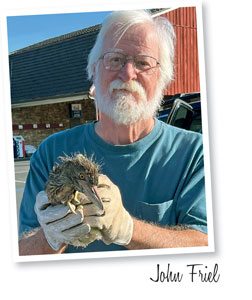9/30/2025
What’s That Buzzing Sound?
John Friel

Not long ago This Space mentioned drones in horticulture. Large nurseries have used them for several years now to detect and treat disease and infestations. More recently, and on a smaller scale, drones are dealing with a recurring nuisance task: Applying liquid greenhouse shade.
Online videos show drones shading huge, multi-acre ranges. But all the factors that make that a good idea still work when you dial down the size.
My former employer, Emerald Coast Growers, used a local drone service at their Pennsylvania range for the first time this year. My son Ben, troubleshooter-in-chief for friendly competitor Creek Hill Nursery, called in a drone strike by the same operator for two of their four locations.
Ben found the pluses numerous, the drawbacks negligible. “It’s the way to go,” he said. “I highly recommend it.”
Pluses include safety, accuracy and savings in time, labor and materials. Nobody climbs ladders, walks peaks and gutters, or drags hoses. A job that took hours last year was done in 20 minutes. Accuracy? “I couldn’t have done it better with a roller and a paint brush. Not a drop is wasted.”
By contrast, ECG’s VP Al Mueller was unsure if they’d do it again. He said, “We under-applied. Next time, we’ll go heavier.”
He pointed out that drones can’t do vertical surfaces like sides, ends or gables. If those are important, they’ll need traditional application methods. Al did say the drone method was “a good price and very quick.”
Creek Hill President Ross Strasko was “skeptical at first,” but “I’m going to keep doing it. It was perfect. It took no time at all.” The drone used half or less of the usual amount of shade, with no under- or over-coated areas: “It got every spot.”
He told me, “I almost don’t want you to write about it. I don’t want their schedule to fill up because everybody’s doing it.”
I’ve always championed appropriate tech, not necessarily high-tech or tech-because-we-can, so it’s welcome news when something once deemed impossibly futuristic comes within reach for mid-size growers.
Enough droning on. Let’s talk about bugs ... It bugged me that after four decades in horticulture, there were still large gaps in my understanding of the field. To help duct-tape over one of those gaps—insects—I’ve been sitting in on virtual entomology classes from Penn State Extension.
While I haven’t learned anything that would make me a grower candidate, it’s been eye-opening.
There are startling limitations on what science actually knows for sure about this massive population whose world intersects, yet has little in common with, ours.
For starters, nobody knows how many insect species there are. Estimates range from 1 million to over 10 million. Quite a spread, right? It doesn’t help that “species” is a fluid term: scientists constantly shuffle taxa among groups or declare them sui generis—just like plant taxonomists.
Writing catalogs and researching nomenclature left me more comfortable with etymology than with entomology. Where do the twain meet? “Common” names, more accurately called colloquial names.
In botany, one man’s monarda is another’s bergamot and yet another’s bee balm. If my neighbor and I blundered into the same patch of Urtica dioica, I’d curse the stinging nettle while he bemoaned the burn hazel. In the parallel universe of entomology, my lightning bug is your firefly (or in another life stage, glow worm) and my cockroach is your palmetto bug.
Other insights: Insects’ eyes are both more and less sensitive than ours. Instructor Michael Skvarla said insects “see farther into the ultraviolet.” But at the lower end of Roy G. Biv, they “generally can’t see red light” at all, which would make them lousy Uber drivers.
I’ll leave you with some quotes that bugged me:
“If all insects on earth disappeared, within 50 years all life on earth would end. If all human beings disappeared, within 50 years all forms of life would flourish.”—Vaccine pioneer Dr. Jonas Salk.
“Insects won’t inherit the earth. They own it now.”—Thomas Eisner, entomologist.
GP
John Friel is a freelance writer with more than 40 years of experience in horticulture.